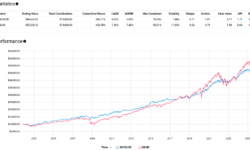
If you’re approaching or planning for retirement, you may have questions about Old Age Security (OAS) benefits, like: Do I need to apply for OAS? How much will I receive in OAS? When do OAS payments go out? We cover these questions and more below. But first, here’s a quick overview of how OAS works.
About Old Age Security (OAS)
Old Age Security benefits are monthly payments made by the federal government to supplement the income of eligible Canadians age 65 and older. Along with the Canada Pension Plan (CPP) and personal savings, OAS provides financial support for older Canadians. CPP and OAS payments are issued on the same dates.
OAS payment dates for 2025
January 29, 2025February 26, 2025March 27, 2025- April 28, 2025
- May 28, 2025
- June 26, 2025
- July 29, 2025
- August 27, 2025
- September 25, 2025
- October 29, 2025
- November 26, 2025
- December 22, 2025
Where does OAS money come from?
The money that funds the OAS comes from the federal government. Individual citizens do not pay into the fund directly.
Who qualifies to receive OAS?
OAS eligibility depends on how long you have lived in Canada, your age and your citizenship. To be eligible for OAS, you must:
- be at least 65 years old; and
- be a Canadian citizen or legal resident
To answer the question of how long you’ve lived in Canada, it depends on where you live now. If you currently live in Canada, you must have lived in Canada for at least 10 years since you were 18 years old. If you live outside of Canada, you must have lived in Canada for at least 20 years since you were 18 years old.
Your employment history doesn’t affect your eligibility. You can even receive OAS if you are still working or have never worked before.
Enrolment for OAS is generally automatic, and you can expect to receive a letter in the month after you turn 64. If you don’t get confirmation of your enrolment, you may have to submit an application to Service Canada. You can do this online or by filling out a paper form.
Note that there are some circumstances when you may be entitled to other benefits, such as if you are widowed, or your spouse or common-law partner is eligible for the Guaranteed Income Supplement (GIS). (More info on the GIS below.)
You can learn more about the OAS program and your eligibility by reading the government’s Old Age Security program toolkit.

Build your retirement savings with 2.00% interest, tax-deferred contributions and zero fees.

Earn a guaranteed 3.35% in your RRSP when you lock in for 1 year.

See our ranking of the best RRSP accounts and rates available in Canada.
MoneySense is an award-winning magazine, helping Canadians navigate money matters since 1999. Our editorial team of trained journalists works closely with leading personal finance experts in Canada. To help you find the best financial products, we compare the offerings from over 12 major institutions, including banks, credit unions and card issuers. Learn more about our advertising and trusted partners.
How much can I expect to receive in OAS benefits?
Good news! The Old Age Security program is indexed to inflation, meaning that the government reviews the program quarterly (in January, April, July and October) and makes increases based on the Consumer Price Index (CPI). (Should the cost of living decrease, your benefits will stay the same.) However, these frequent adjustments make it difficult to predict the exact amount.
These are the maximum amounts anyone can receive from January to March 2025 based on age and income threshold:
| Age | Maximum monthly payment amount | To receive the OAS, your annual net world income in 2023 must be |
|---|---|---|
| 65 to 74 | $727.67 | Less than $142,609 |
| 75 and over | $800.44 | Less than $148,179 |
The amount you, personally, will receive in OAS benefits depends on three main factors:
1. The number of years you’ve lived in Canada since you were 18 years old
If you’ve lived in Canada for at least 40 years since you turned 18, you’ll likely be eligible for the maximum pension payout amount. The CRA also notes there are some situations where you might qualify for the full OAS pension without having 40 years of residence—consider calling Service Canada to inquire (1-800-277-9914).
If you don’t qualify for the full OAS pension, you might be eligible for partial OAS, says the CRA: “If you live in Canada when you apply, you can receive a partial OAS pension if you have lived in Canada for at least 10 years after the age of 18. If you live outside of Canada when you apply, you can receive a partial OAS pension if you have lived in Canada for at least 20 years after the age of 18.”
2. Your age when you begin receiving your OAS pension
You can start receiving OAS at age 65. However, you can choose to delay your start date up to 60 months (which is five years) in return for a monthly 0.6% increase in your eventual pension payment. Using the September 2024 maximum monthly payout amount of $718.33 as an example, this is how delaying your start date could affect your pension.
| Age | Percentage increase | How much you could get for your OAS pension (July to September 2024) |
|---|---|---|
| 65 | n/a | $718.33 |
| 66 | 12 months x 0.6% = 7.2% | $770.05 |
| 67 | 24 months x 0.6% = 14.4% | $821.77 |
| 68 | 36 months x 0.6% = 21.6% | $873.49 |
| 69 | 48 months x 0.6% = 28.8% | $925.21 |
| 70 | 60 months x 0.6% = 36% | $976.93 |
3. Your current income
Over a certain net annual income level, you may not be eligible for OAS, and you may have to repay some or all of your OAS benefits through the pension recovery tax (OAS clawback). Keep reading for more details.
The federal government recently introduced an online tool for estimating OAS, the Old Age Security Benefits Estimator.
Should I wait to start collecting my OAS?
You might be wondering whether you should delay your OAS start date after your 65th birthday. The answer will depend on your life and health circumstances, your retirement plans, whether you intend to continue working and, if so, what your income will be. A financial advisor can help you decide what’s best for you.
The federal government notes, “After age 70, there is no advantage in delaying your first payment. In fact, you risk losing benefits. If you are over the age of 70 and are not receiving an Old Age Security pension, apply now.”
Tools
Find a qualified financial advisor near you
Search our directory of credentialled advisors providing financial and investing services across Canada.
Are OAS benefits taxable?
Yes, OAS benefits are taxable as income. If you want to have your taxes deducted automatically each month, you can sign into your My Service Canada Account or complete the “Request for Voluntary Federal Income Tax Deductions – CPP/OAS” form (ISP-3520OAS). Otherwise, you may have to pay your income tax quarterly.
Can my OAS be “clawed back”?
If you’re a high-income Canadian over the age of 65, you may have to repay some or all of your OAS pension under the pension recovery tax. Whether you will have to repay, and how much, depends on your “net world income” in a given year and the minimum recovery tax threshold for that year. Each year also has a maximum recovery tax threshold—at that point, the entire OAS amount will be clawed back.
Let’s look at how income affects OAS, plus strategies on how to reduce or avoid OAS clawbacks.
The CRA says net world income means income from all Canadian and foreign sources, including:
- Employment
- Business
- Pensions
- Social security
- Capital gains
- Rental property
- Interest
- Dividends
How to calculate OAS clawbacks
If your income is above a certain amount in a given year, you’ll have to repay some or all of your OAS. The recovery threshold changes each year, but the calculation remains the same: You pay back 15% of the difference between your income and the threshold amount for the year.
For example, for income year 2024, the minimum income recovery threshold amount is $90,997. If your total taxable income in 2024 was $120,000, then your repayment would be 15% of $29,003 (the difference between $120,000 and $90,997). That comes out to $4,350.45.
OAS clawbacks are paid off in 12 monthly payments, starting in July of the following tax year (in this case, 2025) and ending the next June (2026, in this example). This July-through-June period is called the “recovery tax period.” Continuing our example: $4,350.45 divided by 12 is $362.54. That’s how much you would repay each month from July 2024 to June 2025.
For income year 2025, the minimum income recovery threshold will be $93,454. For taxpayers aged 65 to 74, the maximum income recovery threshold (above which the full amount of OAS will be clawed back) is $151,668, and for those aged 75 and older, it is $157,490. Learn more about OAS recovery tax thresholds.
How can I avoid OAS clawbacks?
With some planning, it may be possible to reduce or avoid OAS clawbacks. One strategy is splitting pension income with a spouse who has a lower marginal tax rate. Another strategy is to base withdrawals from your registered retirement income fund (RRIF) on the younger spouse’s age—your minimum withdrawals may be lower. Keep in mind that different kinds of investment income are taxed differently, too. (Learn more about how passive income is taxed.) Consider speaking to a financial advisor or tax planner about these and other strategies.
What is the Guaranteed Income Supplement (GIS)?
The Guaranteed Income Supplement (GIS) is a part of the OAS program that provides an additional, non-taxable monthly payment to Canadian residents who receive the OAS and whose previous-year income is below a certain threshold. Like OAS, the GIS is indexed to inflation.
The income threshold changes annually. For example, from January to March in 2025, the threshold is $22,056 for a single person. If your 2024 income was less than that, you may qualify for the GIS. If you do, your maximum monthly OAS payment amount is up to $1,086.88.
For couples, the maximum income thresholds for combined annual income in 2024 are:
- $29,136 if your spouse/common-law partner receives the full OAS pension; your maximum monthly payment is up to $654.23
- $52,848 if your spouse/common-law partner does not receive OAS; your maximum monthly payment is up to $654.23
- $40,800 if your spouse/common-law partner receives the Allowance benefit (a non-taxable payment for Canadians aged 60 to 64 whose partner is eligible for the GIS and your combined income is below the threshold for the Allowance); your maximum monthly payment is up to $1,086.88
If you don’t receive a letter from the government about the GIS, you can submit an application through a My Service Canada Account or by filling out a paper form and submitting it to Service Canada. You can apply for OAS and the GIS at the same time. Learn more about applying for the GIS.
Learn more about the OAS program
What to expect when receiving OAS at 65
How to manage your account when you’re notified of OAS benefits.
Should you collect CPP and OAS while working in your 60s?
If you’re in your 60s and plan to remain in the workforce, here’s what you need to know about applying for your government pensions.
Delaying CPP and OAS to age 70: Is it worth the wait?
The longer you wait to use CPP and OAS, the more you could earn monthly. But with the recent boosts, is it more tempting to use these benefits?
OAS entitlement and deferral rules for immigrants to Canada
If you move to Canada in middle age, you won’t be entitled to the maximum Old Age Security pension. Find out the impact of OAS deferral in this case.
Should you apply for OAS even if you have a high income?
If you are a high-income senior whose Old Age Security would be fully clawed back, find out if you should still apply.
Planning for retirement with little or no savings to draw on
Financial advice often caters to wealthier Canadians. What can retirement look like for those without healthy RRSPs or other savings?
OAS clawbacks
When to watch out for OAS clawbacks
Working in retirement? Beware clawbacks. Find out how to avoid clawbacks on your OAS pension.
How to avoid OAS clawbacks when you’ve had a temporary increase in income
What to do if a one-time bump in income triggers an Old Age Security benefit clawback.
“Should I sell off some investments to avoid OAS clawbacks?”
Cam is already feeling heavily taxed in retirement and wonders if he should get rid of his dividend-paying investments to avoid losing Old Age Security benefits.
OAS allowance for a surviving spouse
Survivor benefits: A guide to CPP, OAS, GIS and more
Pension rules for widows and widowers, explained.
CPP and OAS after the death of a spouse
How to manage split pensions after the death of a spouse.
Newsletter
Get free MoneySense financial tips, news & advice in your inbox.
More about retirement:
- Planning for retirement with little or no savings to draw on
- 40 and no pension: What do you do?
- Single, no pension? Here’s how to plan for retirement in Canada
- What happens when you can’t manage your investments anymore?
- Can you help your kids financially without compromising your retirement?
- Can you delay a RRIF withdrawal?
- RRSP to RRIF, and LIRA to LIF: How it all gets done
The post OAS payment dates in 2025, and more to know about Old Age Security appeared first on MoneySense.



